
The Pokajnica Monastery (Serbian : Манастир Покајница, romanized: Manastir Pokajnica, lit. "Repentance Monastery") is a monastery complex in Velika Plana, Serbia.

The Pokajnica Monastery (Serbian : Манастир Покајница, romanized: Manastir Pokajnica, lit. "Repentance Monastery") is a monastery complex in Velika Plana, Serbia.
The monastery served as a parish church until 1954, when it was turned into a monastery. Originally built in 1818, the interior of the Church's iconostasis was carved by a local craftsman. [1]
In the churchyard there is a wooden bell tower as well as living quarters, probably from the time of construction of the church, with wooden bars on the windows. Conservation work on the church were carried out in 1951, and on the iconostasis in 1987–88.
In 1979 the Republic of Serbia declared Pokajnica a Monument of Culture of Exceptional Importance, and as such it is protected by law.
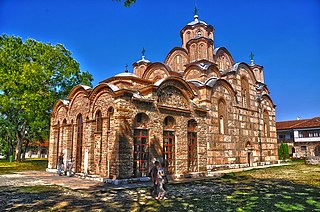
The Gračanica Monastery is a Serbian Orthodox monastery located in Kosovo. It was built by the Serbian king Stefan Milutin in 1321. The monastery was declared a Monument of Culture of Exceptional Importance in 1990, and on 13 July 2006 it was placed on UNESCO's World Heritage List under the name of Medieval Monuments in Kosovo as an extension of the Visoki Dečani site, which was overall placed on the List of World Heritage in Danger.

The Ljubostinja Monastery is a Serbian Orthodox monastery near Trstenik, Serbia. Located in the small mountain valley of the Ljubostinja river, the monastery is dedicated to the Holy Virgin.
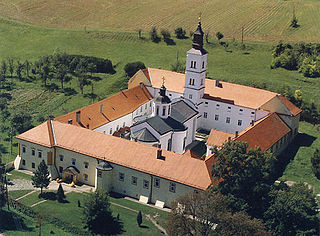
The Krušedol Monastery is a Serbian Orthodox monastery on the Fruška Gora mountain in the Syrmia region, northern Serbia, in the province of Vojvodina. The monastery is the legacy of the last Serbian despot family of Syrmia - Branković. Dedicated to the Annunciation to the Blessed Virgin Mary, it has been described as the "spiritual beacon" of Fruška Gora and "Second Studenica".
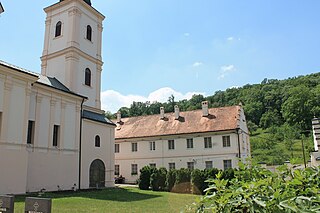
The Beočin Monastery is a Serbian Orthodox monastery, located just outside Beočin, on Fruška Gora mountain in the northern Serbian province of Vojvodina.

The Vrdnik-Ravanica Monastery, also known as Little Ravanica, is a Serbian Orthodox monastery in Vrdnik in the Fruška Gora mountains in the northern Serbia, in the province of Vojvodina. The exact date of its founding is unknown. The records indicate that the church was built at the time of Metropolitan Serafim Jovanović, in the second half of the 16th century. The present church in the monastery was constructed in the period from 1801 to 1811. The icons on the altar screen and the vaults were painted by Dimitrije Avramović in 1853.

The Grgeteg Monastery is a Serb Orthodox monastery on the Fruška Gora mountain in the northern Serbia, in the province of Vojvodina. According to tradition, the monastery was founded by Zmaj Ognjeni Vuk in 1471. The earliest historical records about the monastery date back to 1545/1546. The monastery had been deserted before the 1690 Great Migration of the Serbs, but a renewal, undertaken by Bishop Isaija Đaković, took place in 1708. Around 1770, the extant baroque church was erected and it underwent restoration in 1898 under the guiding hand of Hermann Bollé. It was then that the residential buildings which enclose the church from all four sides were reconstructed. The first walled rocaille iconostasis in the church interior was painted and inlaid by Jakov Orfelin in 1774–1775. The extant iconostasis is a 1902 work of Uroš Predić.

The Divša Monastery, also known as Đipša (Ђипша), is a Serb Orthodox monastery on the Fruška Gora mountain in the northern Serbian province of Vojvodina. It is believed to have been founded by Despot Jovan Branković in the late 15th century. The earliest historical records about the monastery date to the second half of the 16th century. Owing to Turkish raids, the monastery was deserted in the 17th century; at the beginning of the 18th century, Dipša was mentioned as an appendage of the neighbouring Kuveždin monastery. Its old church underwent reconstruction in 1744, but the final alteration was made in 1762, when a new narthex was built. A chapel dedicated to the Mother of God was placed therein, upstairs. The iconostasis for the restored church was carried out by Teodor Stefanov Gologlavac in 1753.

The Jazak Monastery is a Serb Orthodox monastery on the Fruška Gora mountain in the northern Serbia, in the province of Vojvodina. The monastery was founded in 1736. The icons on the baroque iconostasis were painted in 1769 by Dimitrije Bačević and the carved woodwork was attributed to engraver Marko Vujatović. An overall reconstruction of the monastery was carried out from 1926 to 1930.
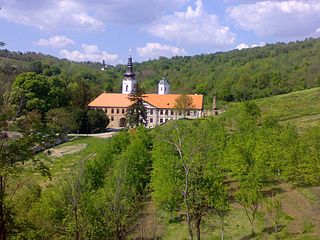
The Kuveždin monastery is a Serb Orthodox monastery on the Fruška Gora mountain in the northern Serbian province of Vojvodina. Traditionally, its foundation is ascribed to Stefan Štiljanović. The first reliable record of its existence is from a Turkish tax book dated from 1566 to 1569, though the building was constructed much earlier. In 2009, the entire monastery complex has been reconstructed.

The Mala Remeta Monastery is a Serb Orthodox monastery on the Fruška Gora mountain in the northern Serbia, in the province of Vojvodina. Its foundation is traditionally ascribed to the Serbian King Dragutin (1276–1282). The earliest historical records relating to the monastery date back to the middle of the 16th century. At the end of the 17th century, Turks had already destroyed it, so when Rača was torn down, the refugee monks came to their appendage Mala Remeta and reconstructed it. The appearance of the earlier church is not known, and the extant one was erected on the same site in 1739. The throne icons on the altar screen were painted by Janko Halkozović in 1759, and the wall paintings are a 1910 work of Kosta Vanđelović.

The Novo Hopovo Monastery is a Serb Orthodox monastery on the Fruška Gora mountain in northern Serbia, in the province of Vojvodina. According to tradition, the monastery was built by the Despots of the House of Branković. The first written mention of the monastery was made in 1451, and the latest mention of the monastery dates back to 1641. The extant church was erected in 1576 and the bell-tower with the small St. Stephen's Chapel upstairs was built between 1751 and 1758. The monastic residences were constructed in several stages, from 1728 until 1771. The icons were painted in 1776 by Teodor Kračun.

The Staro Hopovo Monastery is a Serb Orthodox monastery on the Fruška Gora mountain in the northern Serbia, in the province of Vojvodina. According to tradition, the monastery was founded by Bishop Maksim. The first reliable mention of the monastery dates back to 1545/1546. It is on the basis of some data from 1751 that an earlier church with timber walls dedicated to St. Nicholas existed. The old church which had collapsed in an earthquake was in 1752 substituted with the extant single-nave building dedicated to St. Panteleimon. The woodcarving of the iconostasis of Staro Hopovo was completed in 1793, and the paintings by Janko Halkozović and Kuzman Kolarić.
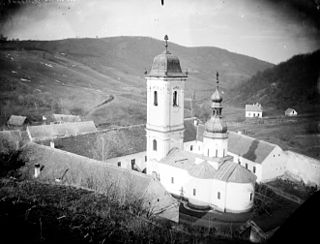
The Rakovac Monastery is a Serb Orthodox monastery on the Fruška Gora mountain in the northern Serbian province of Vojvodina. The monastery of Rakovac with its church dedicated to the Holy Healers Cosmas and Damian, as tradition has it, was founded by Raka Milošević, Chief Chamberlain to Despot Jovan Branković, according to a legend written in 1704. The legend states that Raka erected the monastery in 1498. The earliest historical records mentioning the monastery are dated to 1545–1546. Inside, there are fragments of the frescoes on the walls which date from the first half of the 16th century. The baroque bell-tower was adjoined in 1735, and the residential building gained its final, three-range shape in 1771. The icons on the baroque iconostasis were painted by Vasa Ostojić in 1763, while the wall paintings in the refectory are 1768 works of Amvrosije Janković.

The Šišatovac Monastery is a Serb Orthodox monastery situated on the Fruška Gora mountain in the northern Serbia, in the province of Vojvodina. The foundation of the monastery is ascribed to the refugee monks from the Serbian monastery of Žiča. The first reliable facts illustrating the life of the monastery date back to the mid 16th century. A great benefactor of Šišatovac Monastery was Sekula Vitković (1687–1754) who in 1731 was appointed regimental commander of the Danube Serbian Militia. The building dates from the 16th century. It was through a donation by Vikentije Popović-Hadžilovac, the Bishop of Vršac, that the new, extant church building was constructed in 1778. The iconostasis is the work of the famed Baroque painter Grigorije Davidović-Obšić.
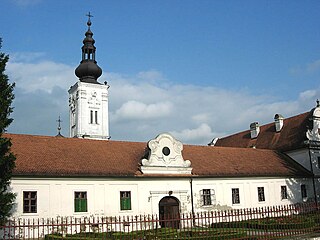
The Bođani Monastery is a Serbian Orthodox monastery in the Bačka region, in the northern Serbian province of Vojvodina. The monastery is near the village of Bođani, in the Bač municipality. Among the few Serbian Orthodox monasteries in the Bačka, Bođani is the oldest.

The Vojlovica Monastery is a Serb Orthodox monastery situated in the Banat region, in the northern Serbian province of Vojvodina. It is in the Pančevo municipality. It was founded during the time of Despot Stefan Lazarević (1374-1427).
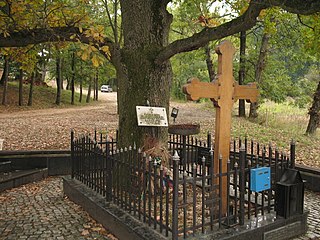
Radovanje Grove is an oak forest located near Radovanje, Serbia. It is a natural memorial monument that covers 46 hectares (0.46 km2). It was first marked during the reign of Alexander Karađorđević, Prince of Serbia, and a memorial church dedicated to Karađorđe was built in 1936. It was categorized as Immovable Cultural Heritage of Exceptional Importance in 1979.

The Koporin Monastery is a monastery at the outskirts of the town of Velika Plana, Serbia, just off the road to Smederevska Palanka. The monastery church, dedicated to St. Stephen, was built during the reign of Despot Stefan Lazarević (1389–1427) whose portrait is preserved as a fresco inside the church, under the inscription "Despot". Stefan Lazarević acquired this title after the Battle of Ankara in 1402, and on that basis the painting was dated. The ktetor and the exact time of the monastery's founding is unknown. Stefan Lazarević is buried in this church. The monastery was in a dilapidated state until the 1880s, when reconstruction began. In the late 1950s and 1960s, massive conservation of architectural elements and paintings was finished.

The Monastery of St. Nicholas is a Serbian Orthodox monastery built by the Grand Prince Stefan Nemanja between 1159 and 1166. It is situated in the center of the historical region of Toplica, near the present day city of Kuršumlija (Serbia), in the upper valley of Toplica river.

Church of the Holy Apostles Peter and Paul, known as the Topčider Church is the Serbian Orthodox Church, located in Topčider park, in the municipality of Savski Venac in Belgrade, the capital of Serbia. Built between 1832 and 1834, it was an endowment of Prince Miloš Obrenović, who was also its founder. It is located next to the Residence of Prince Miloš. The church was declared a cultural monument and protected by the state in 1949.
44°18′37″N21°03′23″E / 44.310380°N 21.056367°E